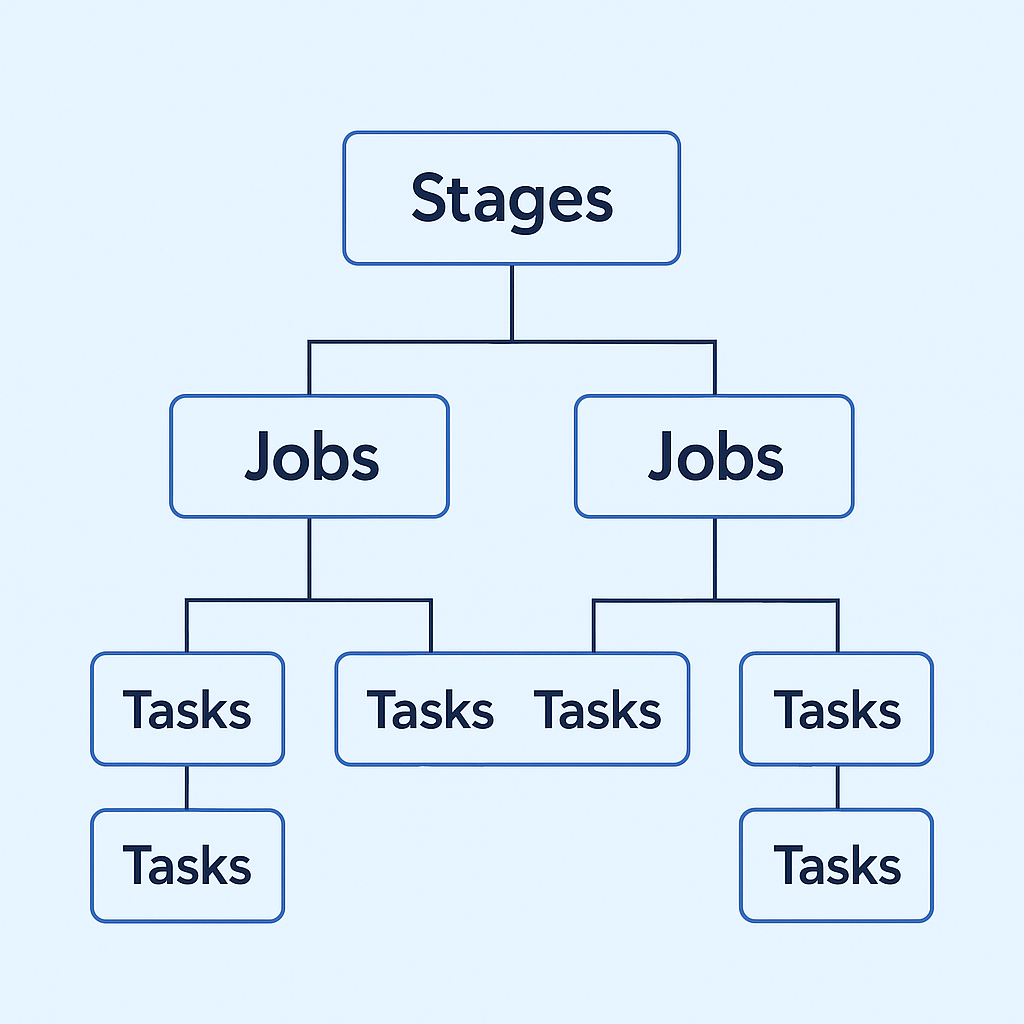Stages, Jobs & Tasks
Azure DevOps Release Pipelines are structured into **Stages, Jobs, and Tasks** to ensure controlled, automated deployments. Understanding these components helps teams manage and execute deployment workflows efficiently.
Understanding Stages, Jobs & Tasks
Release Pipelines in Azure DevOps consist of three key components:
- Stages: High-level phases in a pipeline representing different deployment environments (e.g., Development, Testing, Staging, Production). Each stage contains jobs that execute tasks.
- Jobs: A job is a logical grouping of **tasks** that run sequentially within a stage. Jobs can be executed in **parallel or sequentially** within the same stage.
- Tasks: These are **individual steps** executed within a job, such as building code, deploying artifacts, running scripts, or sending notifications.

Structure of Stages, Jobs, and Tasks in Azure DevOps
Key Concepts
- Each **stage** can contain multiple **jobs**, representing different phases of deployment.
- Each **job** consists of multiple **tasks** that define the execution steps.
- Stages can be executed **sequentially or in parallel** based on deployment needs.
- Approval gates can be configured **before moving to the next stage** to ensure controlled deployments.
- Jobs can be run on different **agents** or **self-hosted environments** based on configuration.
Defining Stages, Jobs & Tasks in YAML
Below is an example YAML pipeline demonstrating how to define **stages, jobs, and tasks**:
stages:
- stage: Build
displayName: 'Build Stage'
jobs:
- job: BuildJob
displayName: 'Build and Compile'
steps:
- task: DotNetCoreCLI@2
inputs:
command: 'build'
projects: '**/*.csproj'
- stage: Test
displayName: 'Testing Stage'
jobs:
- job: UnitTests
displayName: 'Run Unit Tests'
steps:
- task: VSTest@2
inputs:
testSelector: 'testAssemblies'
testAssemblyVer2: '**/*.Tests.dll'
- stage: Deploy
displayName: 'Deployment Stage'
jobs:
- deployment: DeployJob
displayName: 'Deploy to Production'
environment: 'Production'
strategy:
runOnce:
deploy:
steps:
- task: AzureWebApp@1
inputs:
azureSubscription: 'AzureServiceConnection'
appName: 'my-web-app'
package: '$(Pipeline.Workspace)/drop/*.zip'
This example demonstrates a **multi-stage pipeline** where:
- Code is built in the **Build Stage**.
- Tests are executed in the **Testing Stage**.
- The application is deployed to **Production** in the final **Deployment Stage**.
Best Practices for Stages, Jobs & Tasks
- Use **separate stages** for different deployment environments (Development, Testing, Production).
- Define **pre-deployment and post-deployment approvals** to prevent unauthorized releases.
- Enable **conditional execution** to handle rollback and different deployment scenarios.
- Use **parallel jobs** to speed up execution time and optimize resource usage.
- Implement **artifact versioning** to ensure rollback to stable builds.
- Monitor deployments with **Azure DevOps logs, alerts, and dashboards** to track performance and failures.
- Use **environment variables** to avoid hardcoding sensitive configurations.
Conclusion
Stages, Jobs, and Tasks in Azure DevOps Pipelines allow teams to create structured, repeatable, and automated deployments. By organizing workflows effectively, teams can improve **deployment efficiency, minimize risks, and ensure smooth rollouts**.
The next step is to explore **Deploying to Azure App Services** and how applications can be hosted and managed in the cloud effectively.